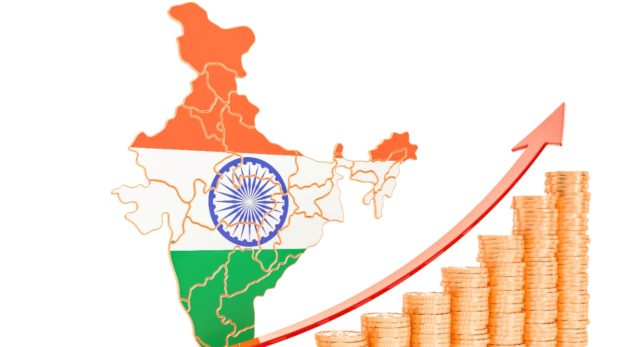- Factors like demographic dividend and domestic consumption have often been cited as the engines of India’s economic growth.
- Now, according to a Deutsche Bank report, India is on track to becoming a $7 trillion economy by 2030 on the back of rapid financialisation, clean energy transition and digital revolution.
- India alone will account for more than a fifth (22%) of the world’s total workforce over the next decade, the report says.
- India’s economic growth over the past two decades has been the second fastest amongst major countries, at an average of 7.5% per annum, only behind China’s 9.6% growth.
India is on track to becoming a $7 trillion economy by 2030 powered by the triple engines of rapid financialisation, clean energy transition and digital revolution, according to a report by Deutsche Bank. This would mean India doubling its economy in seven years from the existing gross domestic product (GDP) of $3.5 trillion.
Factors like demographic dividend and domestic consumption have often been cited as the engines of India’s economic growth.
“Achieving such high growth consistently over a medium-term time frame will need more than demographics or consumption, often recognised as India’s twin strength,” said the Deutsche Bank report, while outlining the other drivers of India’s economic growth going forward.
India’s economic growth over the past two decades has been the second fastest amongst major countries, at an average of 7.5% per annum, only behind China’s 9.6% growth. Doubling its economy over the next 7 years will require other growth drivers.
Rapid financialisation, thanks to JAM trinity
The JAM trinity – Jan Dhan, Aadhaar, and Mobile – has been used to not only plug subsidy leakages and provide welfare benefits directly to the eligible people, it has also driven government efforts with respect to financial inclusion. The report states that there are now 481 million beneficiaries with ₹1.89 lakh crore in deposits in bank accounts.
These previously unbanked users, who now have bank accounts thanks to JAM, can also avail of loans from regulated lenders instead of loan sharks.
Enabling rapid financial inclusion has also helped the government steady its revenue streams thanks to the goods and services tax (GST), which came into force in 2017. GST now contributes nearly $20 billion on average every month to government revenue.
Clean energy transition
With fossil fuels becoming less sustainable due to their costs and the impact on the environment, India’s transition to clean energy is another growth driver, according to Deutsche Bank.
Household access to electricity is now at nearly 100%, while the share of biomass in India’s energy matrix has declined by more than 50%. Renewable energy sources contribute to nearly 40% of India’s total installed energy capacity, and this is projected to increase to 60% by 2030. In terms of absolute numbers, India is projected to increase its renewable energy capacity from the current 157 gigawatt to 497 gigawatt by 2030.
The reduction in reliance on fossil fuels will also help India cut its trade deficit, since it is still a net importer.
“Renewable energy in India promises to be an enabler of several key strategic objectives such as advancing sustainable economic development; improving energy security and mitigating climate change,” the report added.
Earlier, a report by Cambridge Econometrics underlined that fossil fuel imports contributed to 20% of India’s inflation between April and May 2022.
Digital revolution
India’s digitisation efforts will be another critical growth driver, according to Deutsche Bank. The report cites various initiatives like the Umang super app for citizen services, Aarogya Setu, the Open Network for Digital Commerce (ONDC), and the Unified Payments Interface (UPI).
“Each of these initiatives has boosted productivity, sharply reduced transaction costs and leapfrogged the country into a digital era in a way unparalleled across the world,” the report said.
UPI, for instance, has 399 banks on its network and has processed 83.75 billion transactions in FY23, with a total transaction value of ₹139 lakh crore.
The value and volume of transactions through UPI are also several times higher than that in China and other developed nations like the US, UK, and Japan, among others.
Putting a number to demographic dividend: India to add 22% to world’s working-age population
While things like ‘demographic dividend’ have often been talked about, the analysts at Deutsche Bank have put this into context – according to the report, India alone will account for more than a fifth (22%) of the world’s total workforce over the next decade.
For context, this is over 32 times higher than the growth estimated for the US, and more than three times that projected for all of Latin America combined. On the other hand, Europe and China are projected to witness a degrowth in their working-age populations.
The report has also identified certain similarities between India’s economic and demographic status of today with that of China’s back in 2007. It says that India’s median age of 28.4 years, its GDP and per capita GDP are all at the same levels as those of China’s in 2007. For context, the Chinese economy is now worth $18.3 trillion.
In addition to these trends, the continued efforts to formalise the informal economy are setting the stage for India to double its economy to become the fourth largest by the end of this decade.
https://www.businessinsider.in/finance/news/india-to-double-its-economy-to-7-trillion-by-2030/amp_articleshow/99381185.cms





